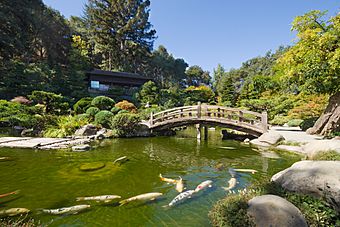Hakone Gardens facts for kids
Hakone Gardens is a beautiful traditional Japanese garden in Saratoga, California, United States. It covers about 18 acres (7.3 hectares). This special garden has won an award called the Save America's Treasures Award. It is known as one of the oldest Japanese-style gardens in the Western Hemisphere. It's truly an important American treasure.
The garden has many cool parts. You can explore a bamboo garden, a quiet Zen garden, and a walking garden called the Hill and Pond Garden. There are also tea houses where people can enjoy traditional tea ceremonies. The Cultural Exchange Center is a copy of a 19th-century tea merchant's home and shop from Kyoto, Japan.
Contents
History of Hakone Gardens
In 1915, a couple named Oliver and Isabel Stine bought the land where Hakone Gardens is today. They were art lovers from San Francisco. They wanted to build a summer house there.
Isabel Stine visited Japan in 1916. She was also inspired by a big event called the Panama–Pacific International Exposition. She decided to design the gardens like the Fuji-Hakone-Izu National Park in Japan. She even named the gardens after it!
She hired Japanese artists and builders to create the gardens. Naoharu Aihara designed the gardens. Tsunematsu Shintani designed the Upper "Moon Viewing" House. Construction of the garden took place between 1917 and 1929.
In 1923, a famous opera called Madama Butterfly was performed in the gardens. Isabel Stine helped start the company that put on the show.
New Owners and Restoration
In 1932, a rich businessman named Major Charles Lee Tilden took over the gardens. He hired a gardener named James Sasaki. Tilden also added the main gate to the gardens.
After Tilden passed away, his sister, Mrs. Walter Gregory, inherited Hakone. When she died in 1959, the garden was not taken care of. Her son then put the property up for sale.
In 1961, several families bought the estate together. These included Joseph and Clara Gresham, their son Eldon and his wife Deon, and four Chinese American couples. These couples were George and Marie Hall, Johnny Kan and Helen Kan, Dan and June Lee, and Col. John C. Young and Mary Lee Young.
This group worked hard to bring Hakone back to its original beauty. They kept its traditional Japanese style. In 1966, they offered to sell the well-kept Hakone to the City of Saratoga. By buying it, Saratoga saved the garden from being turned into something else.
The City of Saratoga hired a gardener named Tanso Ishihara. He worked with architect Kyoshi Yasui to make a plan to make the gardens even bigger. The original gardens, ponds, waterfalls, and paths were fixed up. New trails were built on the hillside.
In 1987, a new garden was added. It was the Bamboo Garden. This was done to celebrate the sister city relationship between Saratoga and Mukō in Kyoto Prefecture, Japan.
Today, The Hakone Foundation takes care of Hakone Gardens. This non-profit group was started in 2000. They work to keep the gardens beautiful without needing money from the government. The gardens are open to everyone. Many cultural events are held there.
Hakone in Movies
Hakone Gardens was used as a place to film the movie Memoirs of a Geisha in 2005.
Design of the Gardens
Hakone Gardens has four main garden areas. Each one has its own special style.
Types of Gardens
- The Hill and Pond Garden
- The Zen Garden
- The Tea Garden
- The Bamboo Garden
The Bamboo Garden is the newest part, finished in 1987. The other three gardens were part of the original design by the Steins. The Hill and Pond Garden is the oldest, finished in 1918.
The Hill and Pond Garden has a waterfall that flows into a large koi pond. There is an island in the pond that you can reach by a bridge. This garden is designed for walking around and enjoying the views.
The Zen Garden has gravel raked into special patterns. It is meant for quiet viewing and thinking. It is a classic dry landscape garden, finished in 1922.
The Tea Garden is designed like a typical garden you would find near a tea house in Japan.
Important Buildings
The old buildings at Hakone Gardens were built using traditional Japanese designs. They look like homes from the 16th and 17th centuries that samurai warriors liked.
The oldest buildings are the Upper House (1918), Lower House (1922), and Tea Waiting Pavilion (1927). The Upper House was like a country home. This is where the tea ceremony would happen. The tea was prepared in the Tea Waiting Pavilion. The Lower House was the Steins' summer home until about 1929. Some changes were made in the 1980s to hold tea ceremony classes.
The Main Gate was added in 1941 when Tilden owned the garden. Tilden also added the Wisteria Pavilion and Arbor, the Moon Bridge, and the Upper Pavilion in the Hill and Pond Garden. The Cultural Exchange Center is one of the newer buildings, finished in 1991.
Images for kids
See also
 In Spanish: Jardines Hakone para niños
In Spanish: Jardines Hakone para niños









